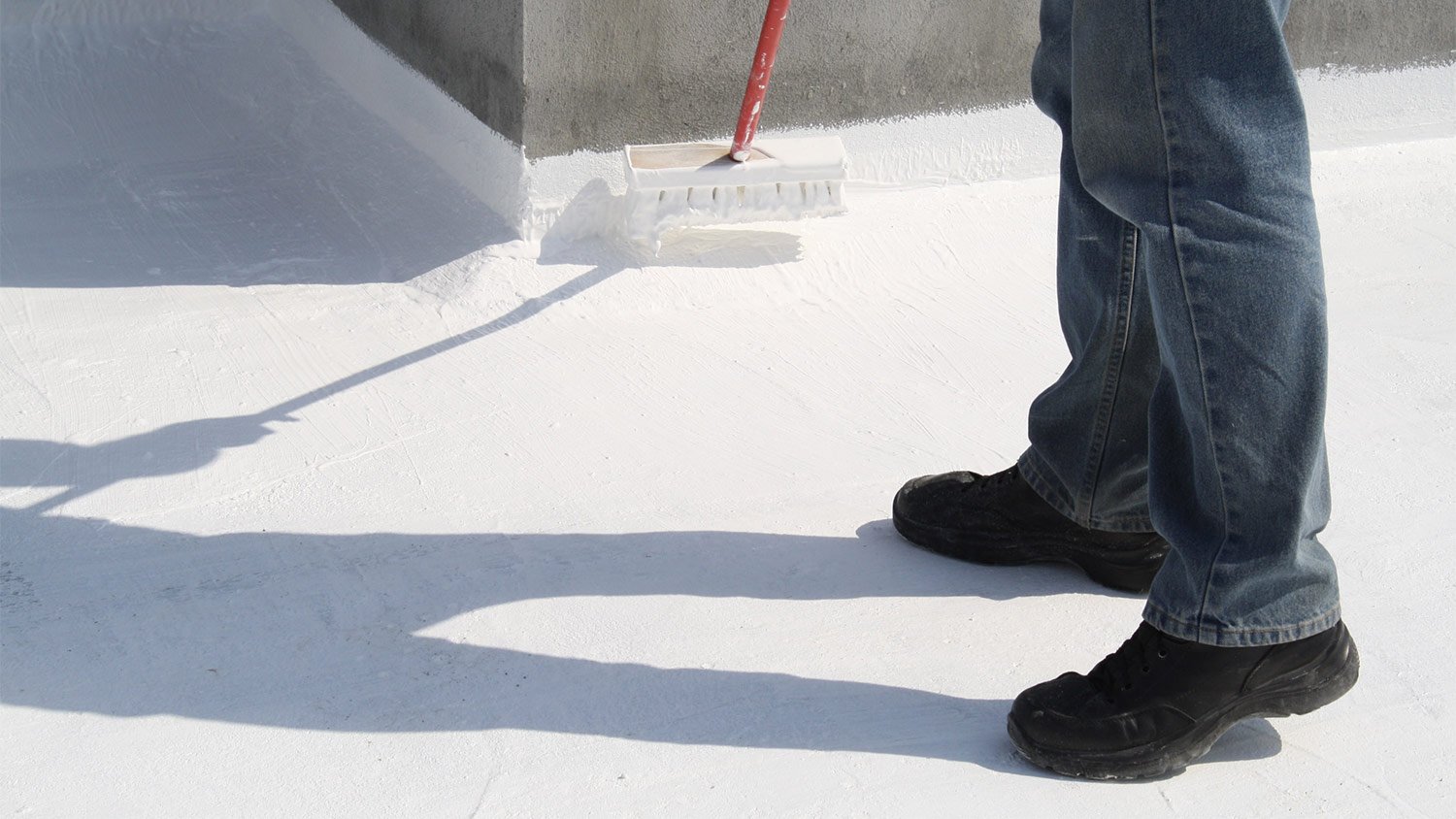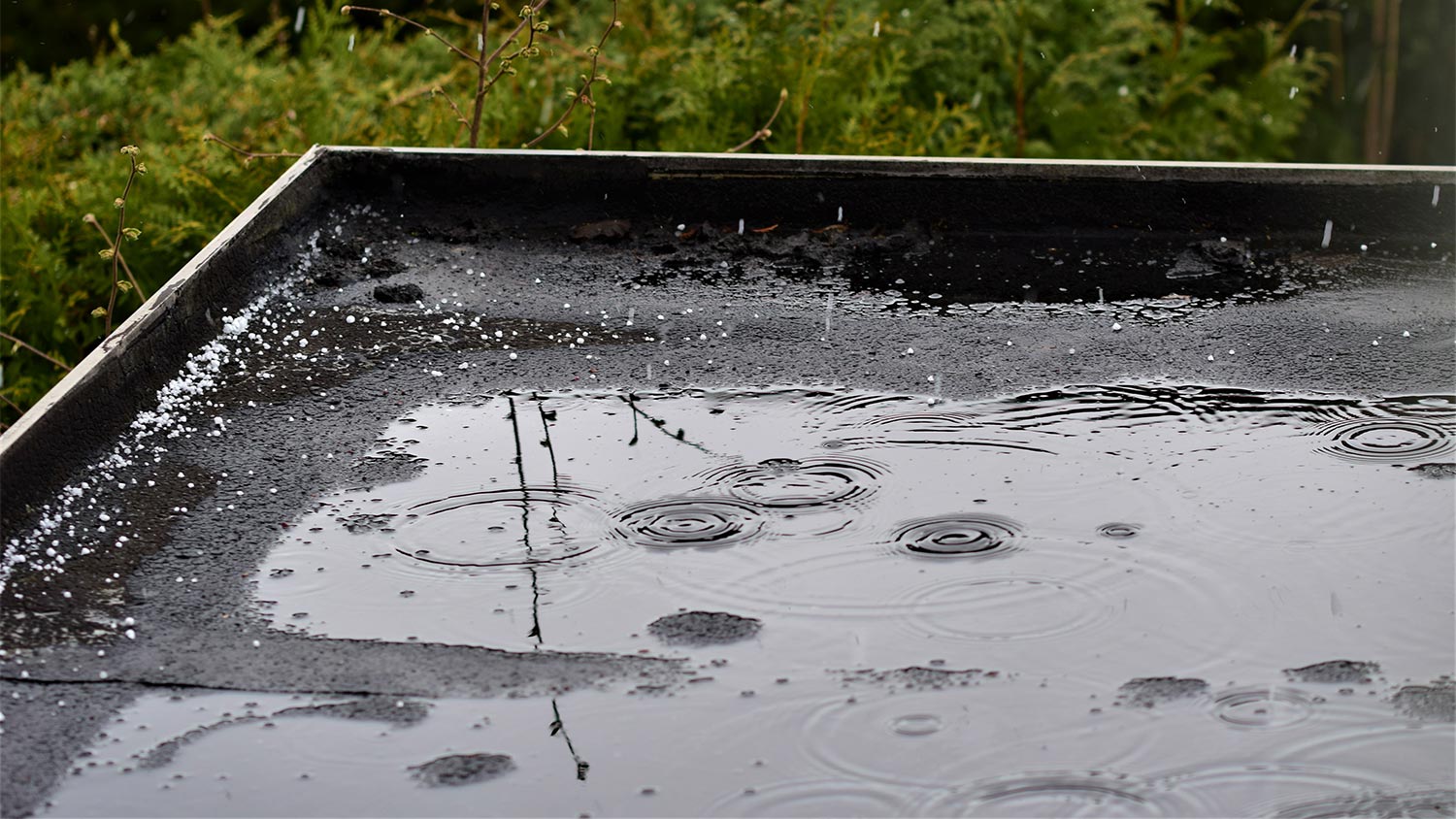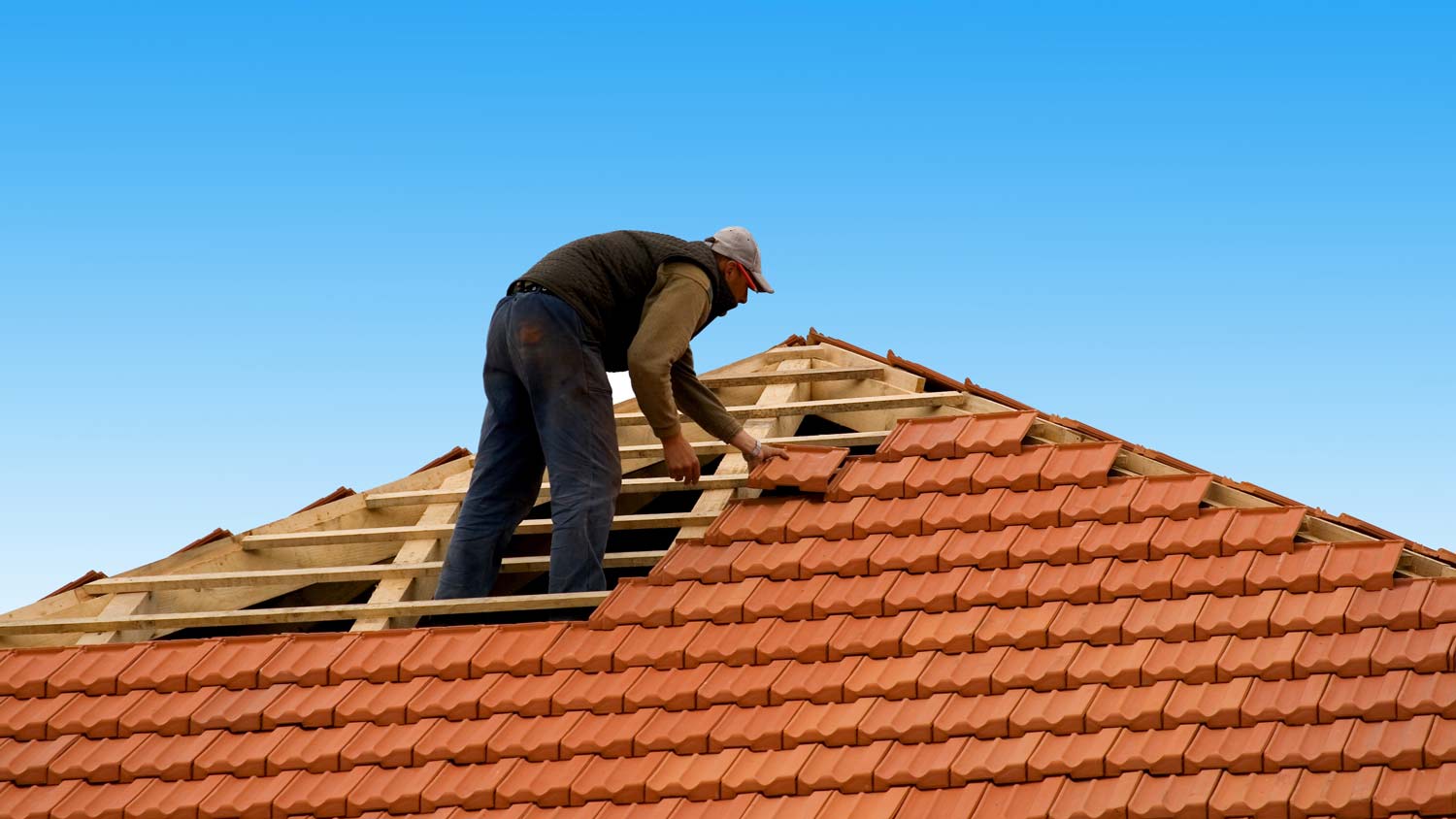
Soffit replacement costs depend on multiple factors, like length, accessibility, and material. Learn about the cost factors to budget more accurately.
Roof sealant can protect your roof and extend its life


Roof sealants can prevent leaks and water damage while prolonging a roof's life span.
Roof sealant works by patching existing damage spots and adding a preventative leak barrier to the entire roof surface.
There are two main roof sealant categories: water-based and solvent-based.
There are five primary roof sealant types, including acrylic, polyurethane, and rubber.
The disadvantages of roof sealant is that it’s challenging to install, attracts dirt, and increases slipperiness, but the benefits usually outweigh these drawbacks.
Keeping your home protected from the elements is your roof’s most important job. However, over time, those elements can take a toll on your roof, leading to roof deterioration and damage. Roof sealant can protect your roof from moisture and UV damage, extending its life. Learn more about the different kinds of roof sealants, the pros and cons of applying sealant, and how to choose the best sealant for your roof.
Roof sealants are adhesive coatings made of rubber, silicone, tape, polyurethane, or acrylic that form a protective leak barrier and can serve as a preventative in areas that are likely to leak over time or as a patch to cover existing roof damage. While roof sealants are part of new roof installations, you can also add them as roofs age to bolster leakproof properties or in reaction to active leaks.
Many sealants are made for use on flat roofs, where pooling water can cause leaks; however, they can prevent and stop leaks on sloped roofs, too. You can use weatherproofing roof sealants to patch roof damage, like cracks or gaps in shingles and flashing, or to seal areas proactively around fasteners, nails, chimneys, solar panels, or skylight installations and other parts of a roof that are likely to leak over time.
For small repairs, spray, caulk, or tape sealant is a great way to stop a leak. You can also apply a layer of liquid roof sealant across the entire surface for whole roof protection. In fact, in some situations, roof sealant can extend a roof’s life span by keeping it from degrading or forming leaks, saving you from premature roof replacement costs. It is important to note, however, that sealants are not meant to repair major leaks, replace missing shingles, or weatherproof large areas of damage.
Roof sealants come in a variety of mediums and application methods. Here are some of the most common:
Liquid roof sealant: Liquid sealant comes in small and large buckets and is most often used to make large repairs and to secure layers of rubber roof membrane.
Spray sealant: Generally used in conjunction with other types of sealant, like caulk or tape, spray sealants can waterproof large areas, especially in emergency situations.
Caulk sealant: Used most often in new installations and best for small-area repairs, caulk sealers go on like any other caulking product to seal up small gaps, holes, and cracks.
Sealant tape: Tears and small holes, especially under shingles and on flat roofing, are easy to fix with sealant tape. A small piece, cut and secured over top of the damage, is usually enough to stop leaks.
When taking on this project, expect questions only a pro can answer. With our network of local pros, you'll get the job done and your questions answered—without the hassle and stress of doing it yourself.
Roof sealants help protect your roof against damage from water and the sun's harsh UV rays, which increases its durability and longevity. That means you can avoid roof repair costs and, likely, the cost of a new roof for several additional years.
Roof sealants not only prolong your roof's life span but also help repair and prevent leaks. And leaks are more than a nuisance—a leaky roof can lead to dangers like sinking ceilings, fire hazards, and more. Not to mention, the cost to repair water damage typically ranges from $1,240 to $5,340. Roof sealant costs an average of $0.65 to $5 per square foot, so protecting against more expensive damage repair or roof replacement is well worth the investment.
Most homeowners are looking into sealing their roofs to repair water leaks, prevent water damage, and maintain their roofs. Hiring a pro helps avoid further damage to the roof and home and ensures the project is completed correctly.
Roof sealants fall into two main categories: water-based and solvent-based. Wondering what is the best roof coating for shingles or what is the best coating for metal roofs? The best roof sealant for your home depends on your circumstances. Good local roofing contractors near you can help determine the best product for your needs.
Water-based sealants are thinner and more affordable than solvent-based sealants. Their thin consistency makes them ideal for filling small cracks, but they are not as good at resisting the outdoor elements as solvent-based sealants, so you will need to reapply more often.
Solvent-based sealants are thicker and more expensive than water-based sealants, but they are the toughest when it comes to protecting against moisture and UV rays. They also often last longer than water-based sealants, so while they might cost more upfront, you likely will not need to reapply them as often.

There are five main roof sealant types. The best type depends on your unique needs and budget.
Rubber sealant is often water-based, but it can be solvent-based as well. It comprises a liquid rubber formula that offers stellar protection against rain and UV rays. Its thin consistency also makes it especially easy to apply to small cracks and leaks.
Silicone sealant is solvent-based and among the most expensive sealant types, but it is also one of the most protective. It is both water-resistant and UV-resistant, so it is a great all-weather option for houses in nearly every climate.
Roof repair sealant tape is a thin, moisture-resistant strip used to repair minor leaks and reinforce roof seams. It comes with an adhesive backing that you can apply directly to your roof, so it is easy to apply and will not leave any messes behind.
Polyurethane roof sealant is solvent-based and quite moisture-resistant, but it does not do a great job of protecting against UV rays. Therefore, it is not ideal for homes in very sunny climates. But if you live in a rainy or gray climate, it is a good option that is less expensive than silicone.
Acrylic sealant comes in water- and solvent-based formulations and offers excellent resistance against UV rays, making it a very popular roof sealant in sunny regions. However, it is only somewhat moisture resistant, so it is not a good bet for homes with flat roofs prone to pooling water.

The right roof sealant for your home depends on several factors, such as how much UV protection and water resistance you need.
All roof sealants offer at least some protection against water, but some types are much better at resisting water than others. If you live in an area with a lot of rain, you should invest in a highly water-resistant roof sealant, such as silicone, polyurethane, or rubber. Acrylic sealants do not offer much water resistance, so it is best to avoid using them in wet climates.
The sun's UV rays can degrade a roof and lead to leaks over time, so folks in sunny regions should opt for roof sealants with a high degree of UV protection. Acrylic sealants are good at protecting against UV rays but do not offer much water resistance. Silicone and rubber, however, can both protect various types of roofing materials against water and sun damage. Polyurethane sealants do not provide much UV protection, so homeowners in sunny regions should avoid this sealant type.
Most roof sealant types last for around 10 to 20 years. You can do several things to help prolong your sealant's life span. Applying multiple coats will help it last longer, as will making sure your roof is clean and dry when you apply it. Many manufacturers advise against applying sealant during cold weather since that can affect its longevity. You will also want to make sure there is no rain in the forecast, so your sealant has at least 24 to 48 hours to dry.
Some sealant types are easier to apply than others. Thicker solvent-based sealants, like silicone, are harder to work with than thinner water-based sealants, like acrylic. However, you often need more coats of water-based sealants than you do solvent-based sealants, so there is a bit of a tradeoff.
When weighing roof sealant options, it is helpful to look for a certification from the International Organization for Standardization (ISO). The ISO certification rates how well a particular sealant can tolerate corrosive environmental elements, like humidity, salt, and pollution. The rating ranges from C1 to C5, with C1 sealants only able to tolerate minimally corrosive elements and C5 sealants able to withstand highly corrosive elements.
For a fair understanding of whether roof sealants are best for your project, consider the following downsides.
Some roof sealants, particularly silicone versions, can attract and hold onto dirt and dust from the air. This layer of dirt and other particles can accumulate on your roof over time, making the roof look grimy and causing a loss of reflectivity. This means the heat from the sun and UV rays will not bounce off as readily, which can increase the heat of your building and increase cooling costs. To prevent this, you will need to pressure wash sealed roofs more often.
When applied correctly on a roof that easily sheds water, roof sealant should not collect puddles. However, some applications and sealed roofs will allow water to pool in lower areas with less drainage. Ponding can create leaks, leave ugly discoloration, encourage algae growth, and contribute to the deterioration of the underlying roofing, especially on flat roofs.
While some people have the experience, tools, and skill to apply roof sealants themselves, these products can be tricky to apply. This is especially true for whole roof applications of liquid sealant and silicone sealants that are known for clogging up spraying equipment. Choosing a roofer who knows the ins and outs of sealant application is important.
If you are using small sealant patches or applying it on an area that does not get traffic, you have nothing to worry about. However, for whole roof applications or applications in areas where people may be walking, it is important to realize that sealant can be slippery, especially when it gets wet. This is why some professionals recommend walk pads or textured areas on sealed roofs that get traffic.
For the best results, you will need to choose a high-quality sealant that is meant for your roof and your climate and install it in the right way. Lower-quality sealants, sealants not meant for your type of roof or climate, and sealants that are not applied correctly will not last as long as they should, and that can leave you with leaks, roof failure, and the need to reseal or replace your roof much sooner than expected.
With the exception of sealant tape, spray, and caulk, most roof sealant is a liquid that’s applied using the following steps:
Clean and prep the roof’s surface according to the manufacturer’s instructions. Let the surface fully dry.
Apply a primer if needed per the product’s instructions.
Apply a thick, even coating of the sealant using a brush or roller, working a few square feet at a time.
Let the product dry and cure according to the instructions.
To apply roof sealant tape:
Clean and prep the roof’s surface according to instructions.
Cut the tape to the size you need.
Remove the backing from one end of the tape and press the adhesive side of the tape firmly onto the roof’s surface. Make sure the tape has no bubbles or wrinkles as it’s applied.
Continue peeling off the backing and pressing the tape onto the surface until the full length of the tape is applied.
Use a roller to apply pressure along the length of the tape to ensure a strong bond with the roof’s surface.
Handy homeowners might be able to DIY an application of roof sealant, but climbing a ladder and working on a roof several stories off the ground poses some serious safety risks. It’s best to call a local roof sealing company to avoid risking a fall and ensure the job is done right.
Lauren Bongard contributed to this piece.
From average costs to expert advice, get all the answers you need to get your job done.

Soffit replacement costs depend on multiple factors, like length, accessibility, and material. Learn about the cost factors to budget more accurately.

Learn all of the factors you need to consider to estimate roof ridge cap replacement costs, whether it’s safe and worthwhile to DIY the work, and more.

Wondering about the cost to tarp a roof after a large storm or before a major roof renovation? We'll break it down by size, style, and scenario.

Understanding the available types of roof trusses helps you create the desired shape and support for your roof. Learn more about the different options.

Find out the average tile roof repair cost, key price factors, and ways to save. Get expert tips to plan your tile roof repair project with confidence.

Dreaming of a tile roof but not in love with how expensive clay tiles are? Concrete tile roof costs are much lower, but you still get that classic look.